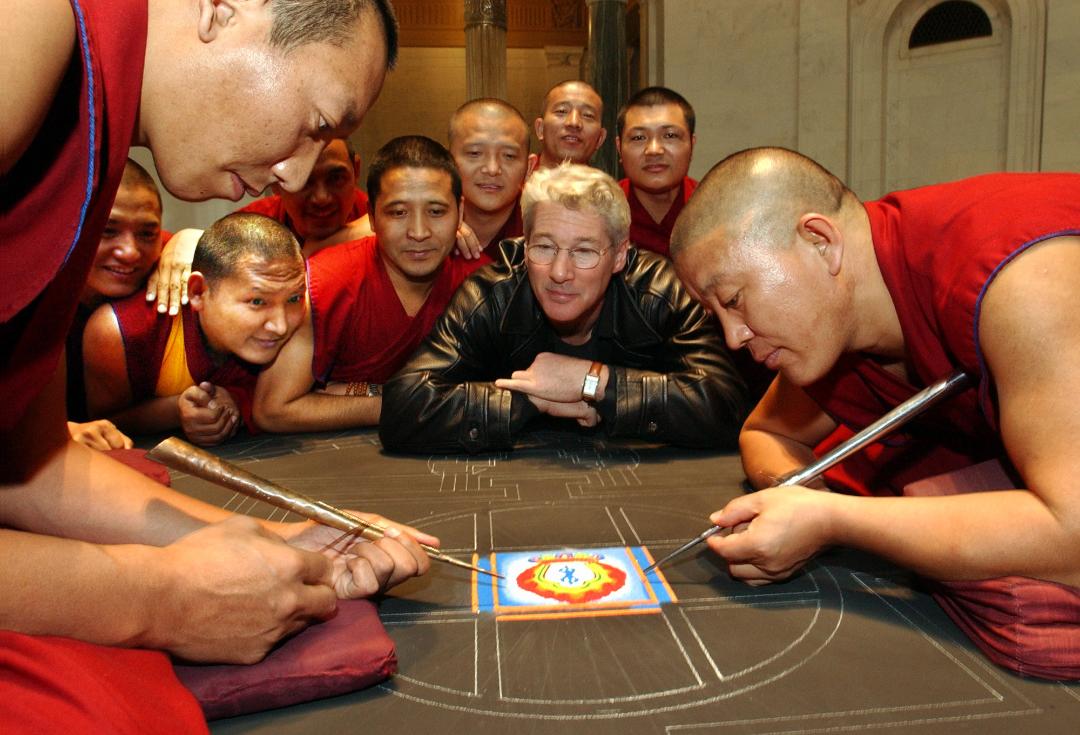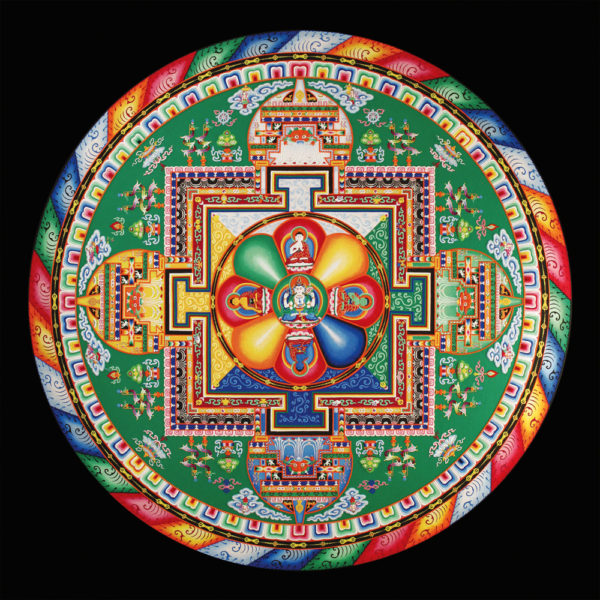
By Michael Curry
The art of sand painting or creating a sacred Mandala is a really ancient one. Evidence suggests that these magnificent creations have been an integral part of age old traditions in cultures ranging from the highest plateau on the planet in Tibet to the Australian aboriginal peoples, the Navajo peoples of the American Southwest and some of the indigenous tribes in Mexico and South America.
SO WHAT IS A MANDALA?
Think of it as a giant, three dimensional jigsaw puzzle. In the Tibetan Buddhist tradition it takes four monks (lamas) working 8 hours a day for three or four days to complete one. But this puzzle is three dimensional and is made out of naturally dyed colored sands (or crushed stones). Once finished, just like that jigsaw puzzle, it is dismantled. By then of course, you will probably think that is a four dimensional puzzle!
Millions of grains of sand are painstakingly laid into a deeply meaningful and minutely intricate pattern. In order to begin the work and to consecrate the space, the lamas perform an Opening Ceremony , calling up the spirits of goodness, which involves chanting accompanied by ancient instruments such as the long horn which takes two people to carry!.
Having memorized all the minute details and subtleties of one of numerous prescribed patterns, this is the architecture of enlightenment. It can take months, if not years for an individual to master the myriad techniques of building a Mandala. Visualization and memory are the keys – basically developing a photographic memory.
Using a compass, rulers and chalk and string , the monks outline the Mandala on a four foot square wooden platform, waist high. They then begin filling in all the details using the traditional Tibetan chakpur or extended funnel. Made of copper, this instrument distributes the colored sands in much the same way as an icing bag decorates a cake – well at least used to! One edge of the chakpur is serrated and when rubbed by the metal rod held in the right hand, aside from making a wonderfully hypnotic sound, the sands flow freely. Based on centuries old iconography, the Mandala represents the cosmos and includes many geometric and a multitude of spiritual symbols. It is a powerful tool for meditation and is used by numerous native peoples as a living reminder of the impermanence of life. Like the medicine wheel in Native American philosophy and folklore, the Mandala is a tool for healing.
Typically, a Mandala has four outer borders that encircle the center which is often the representation of a particular deity…this center space being completely pure. The outermost ring is a vibrant wreath of flames, the second is one of diamond scepters or vajras. These help clear the space and establish the basic spiritual themes.
Once finished, the Mandala is blessed by the monks in the closing ceremonies which invoke thanks and respect and then it is ritualistically dismantled. The sands are swept up; half are placed into an urn and the other half is distributed to the attendant audience. The urn is then carried by the monks in ceremonial robes in procession to Mill Creek at the foot of Mellen Street in Phoebus. The sands are poured into the waters while the monks chant, fulfilling the function of healing. The waters then carry the healing powers and blessings into the oceans, thereby spreading across the globe.

20 YEARS OF VISITS BY THE MONKS
The first group of Tibetan monks from Drepung Loseling Monastery came to Hampton in the Summer of 1999, causing a sensation with the building of a Mandala in the Charles H. Taylor Arts Center and with their performance of Sacred Music and Sacred Dance in the First Presbyterian Church (sold out performance). This was while the American Theatre was under renovation and construction. In subsequent years, the monks have been in residence each summer at the American Theatre. In years gone by, they created many different sand paintings, gave repeat performances of sacred music and sacred dance and added many additional events including free lectures, films, workshops and classes. And, not too surprisingly, they enjoy their rarely found free time by playing basketball or soccer (with no rules) or just going to the beach!
The Mystical Arts of Tibet tours began 30 years ago with the blessings of The Dalai Lama and the patronage and encouragement of famed actor Richard Gere and world renowned Tibetan scholar Dr. Glenn Mullin. Over the years, the monks from Drepung Loseling Monastery have enthusiastically shared their wisdom as well as their rich traditions which date back more than 2,500 years. Hundreds of thousands have now enjoyed these performances and exhibitions which regularly take the monks to leading performing arts centers, museums, outdoor festivals and university campuses across the Nation.
Staunch advocate for the Tibetan cause, actor Richard Gere comments: “The productions by the monk artists of Drepung Loseling Monastery are both highly professional and beautiful and express the purity and sophistication of the Tibetan sacred performing and visual arts. I am deeply honored to be associated with these productions.”
Renowned for their unique multi phonic chanting (in which the monks can intone three notes of a chord at one time), the Drepung Loseling monks were featured on the soundtracks of the two most famous (and accurate) of motion pictures about Tibet and its enduring culture – those films being Seven Years in Tibet and Kundun. The monks have also performed before crowds of hundreds of thousands in New York’s Central Park, on the National Mall in Washington D.C. for the Smithsonian Folk Festival, the Field Museum in Chicago and at Centennial Park in Atlanta (among many other prestigious venues).
THE MONASTERY: HERMITAGE OF THE RADIANT MIND
While the word monastery might conjure up thoughts of religion, it is vital to note that His Holiness the Dalai Lama does not use that term. He prefers for us to think of Buddhism as a “Science of the Mind”.
Established more than 600 years ago, just north of Lhasa (the capital of Tibet), Drepung Loseling Monastery (meaning Hermitage of the Radiant Mind)was one of the world’s largest monastic universities, housing more than 10,000 monks. When the Chinese invaded Tibet in 1959, the communist regime forcibly closed more than 6,000 monasteries, destroying and ruining centuries of precious building, culture and traditions. Thankfully, some 250 monks from Drepung Loseling did manage to escape, risking their lives in treacherous conditions as they crossed the Himalayas into Nepal and India. The Government of India has always welcomed refugees from the ravaged nation and indeed established a colony in the state of Karnataka in Southern India. It is here that the Drepung Loseling monks re-established the monastery ( in exile) and there are now more than 3,000 monks in residence at the revered institution. It is important to note that monks and nuns are still, to this day taking the courageous and dangerous risks of escaping into exile.
In 1991, as a direct result of the overwhelming response to the Mystical Arts of Tibet tours, the monks were invited to establish a seat (or home) in North America and this they did in Atlanta. As the nonprofit institution has grown it has become an affiliate of Emory University. This remarkable pioneering partnership was launched by the Dalai Lama in 1998. Together, these two institutions now provide a venue for the preservation and study of the Tibetan Buddhist traditions of wisdom and compassion and nurtures an environment for inner peace, community understanding and global healing. Emory and Drepung Loseling are deeply committed to preserving the endangered Tibetan culture.
Further cementing this trailblazing collaboration, Emory University named The Dalai Lama its Distinguished Presidential Professor – this is the only Professorship His Holiness has accepted in the Western world. As Visiting Professor he has had and continues to have a lasting and meaningful role of leadership and inspiration . A Nobel Peace Prize winner (as well as holder of thousands of awards, honorary degrees and accolades), the Dalai Lama is one of the world’s most recognized and revered leaders. Now 83 years old, he is a constant source of love and compassion to millions. Enthroned at the tender age of 5, he assumed all duties as Spiritual and Political leader of the more than 6 million Tibetans when he was just fifteen. Ever since his dramatic and dangerous escape from his homeland in 1959, he has been teaching the world that we are indeed one people… all brothers and sisters. He has given up his political positions and created the Tibetan Government in Exile. He is, of course, still the spiritual leader of his peoples and world advocate for peace and mutual respect.
“In the 21st century, science and spirituality have the potential to be closer than ever, and to embark upon a collaborative endeavor that has far reaching potential to help humanity meet the challenges before us,” said H.H. The Dalai Lama.
Summing up the 20 years of visiting Hampton, Geshe Lobsang Tenzin Negi says: “The venerable monks and all the staff at Drepung Loseling Monastery are deeply honored by our association with Hampton and the greater coastal region of Virginia. Since Michael Curry first presented us here (when I was still a monk) we have been the recipients of so much love and respect. Thank you Hampton for embracing and encouraging our goals of compassion.”
Geshe Lobsang is the Spiritual Director of Drepung Loseling Monastery in Atlanta and a Senior Professor at Emory University. The title, Geshe, means Dr. here in the Western world and Geshe Lobsang has the rare distinction of being a PhD in his own traditional monastic training but also being a PhD in western academics. He is now a prominent and much sought after leader in the burgeoning movement exploring the boundaries of meditation and of fulfilling the Dalai Lama’s vision for the convergence of science and spirituality. He has been a hugely instrumental player in the establishment of the brand new Center for Science and Meditation in India and in the field of contemplative sciences.
WANT TO GO?
Tibetan Buddhist Monks
Opening ceremonies: Thursday Aug. 9, 7pm
Creation of the Mandala: Fri. Aug 10, 10am -6pm; Sat. Aug. 11, 10am-6pm. Sun. Aug 12: Completion
Closing ceremonies and distribution of the sands into the water: Sun. Aug 12. 1pm.
All events free and open to the public.
American Theatre



